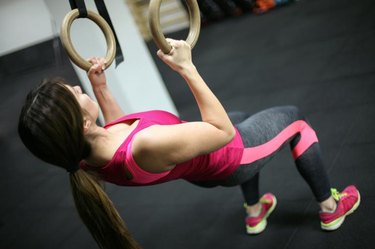
From strapless dresses to tight-fitting tees, clothes fit better when your back is lean and toned. A strong back also helps you tackle life with ease -- whether you're lifting your kids or lifting your groceries. Getting toned requires that you build up your back muscles and that you burn off excess fat those muscles are hiding beneath. Eating a healthy diet, doing regular cardio and strength-training will get you there.
Toning: A Two-Part Process
Video of the Day
In order to get that desirable definition between your muscles you have to have two things:
Video of the Day
- Developed musculature
- A low enough body fat percentage that your muscles aren't lost in fat
Everyone has back muscles, but not everyone has developed mack muscles. This doesn't mean you need to look like a bodybuilder, but working your back muscles will help them grow a little bigger so they stand out more for that toned look.
However, they won't stand out if they're covered in a thick layer of fat. The more lean your body is -- i.e., the higher the ratio of lean muscle mass to body fat -- the more definition you'll see.
Get Your Diet Under Control
Any toning regimen should start in the kitchen. To get that lean look, you need to burn fat and keep your calorie intake in balance with your calorie output. If you're wearing a few extra pounds these days, start by reducing your calorie intake.
Cut out foods that aren't nutritionally nourishing, such as sweets, processed snack foods and sugary beverages. Focus on high-nutrient vegetables and fruits, whole grains, lean meats and fish, low-fat dairy and nuts and seeds in small amounts. Eating this type of diet makes it much easier to stay in a calorie deficit -- where you're eating fewer than you burn. That's key for shedding fat.
Read more: The 7 Principles of Fat Loss
Do Cardio Like Your Life Depends on It
OK, perhaps that's overstating things. But regular cardio exercise is crucial for toning. You just can't skip it. So find an activity that you like to do and do it often. Whether that's jogging, skipping rope, dancing, climbing stairs, cycling or wrestling alligators, as long as it gets your heart rate up and makes you sweat, it's burning calories.
If you're ready to step it up a notch or two, work in a couple days a week of high-intensity interval training. This type of cardio has been proven to be better at burning fat than steady-state cardio. In a cardio interval-training workout, you alternate periods of intense exercise with periods of recovery. This causes your heart rate to rise and fall over and over again and has a more marked metabolic effect.
An example of this type of workout would be doing interval sprints. After warming up for 5 minutes, increase your speed to an all-out sprint. No holds barred, go as fast as you can. Hold that pace for as long as you can. Maybe at first that's 30 seconds. Gradually increase it. When you're pooped, slow down to a jog or fast-walk. Recover at that pace for as long as you sprinted. Repeat the whole thing for a duration of about 20 minutes, then cool down for a few minutes.
How much cardio you need to do depends on how much weight you have to lose and how many calories you're able to trim off your diet. As a rough estimate, creating a deficit of 500 to 1,000 calories per day can help you shed 1 to 2 pounds of fat a week.

Give Your Back a Boost
The more muscle you have on your back, the more definition you'll see when you start to shed body fat. But you don't just want to train your back muscles. That will lead to muscular imbalances. It will also limit the metabolism boost you get from total-body strength training.
What you need is a total-body strength-training program that targets all of your major muscle groups -- back, arms, chest, abs, legs and butt. When your goal is to burn fat and build muscle at the same time, total-body routines made up of compound exercises are the way to go.
Compound exercises work more than one muscle group at a time. For example, a push-up is a compound exercise that works your arms, shoulders, chest, abs and even your legs and back. Other examples include squats, deadlifts, push-ups, pull-ups, step-ups, lunges, dips and rows. Rows, deadlifts and pull-ups specifically target the back muscles, but they work other muscle groups as well.
For a fat-burning boost, you can use the interval-training method in your resistance workout. Choose five or six compound exercises and an ab exercise and set them up in a circuit, so you can easily jump from one to the next. Do one set of each exercise for 30 seconds to one minute, then immediately move to the next exercise with no rest in between. Once you've completed one set of each exercise, rest for a minute or two, then do another round. Do three to six rounds total.
Aim to train all your major muscle groups two to three days a week. If you're doing a total-body program with compound exercises, be sure you're choosing exercises that work the back muscles, such as the ones mentioned above, in addition to all the other muscle groups. If you're doing a split routine, in which you work different muscle groups on different days -- for example, back and biceps -- just be sure to allow a day or two in between training sessions to give your muscles time to recover.
Read more: 20 Fat-Loss Secrets